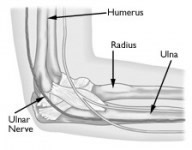Cubital Tunnel Syndrome occurs when the ulnar nerve in the arm becomes compressed at the elbow joint. The ulnar nerve travels through a tunnel of tissue just adjacent to the medial epicondyle of the elbow. Beyond the elbow, the ulnar nerve travels under muscles on the inside of your forearm and into your hand on the side of the palm with the little finger. As the nerve enters the hand, it travels through another tunnel (Guyon’s canal).
The ulnar nerve gives sensation to the little finger and half of the ring finger on both the palm, and dorsal aspect of the hand. It also supplies most of the small muscles of the hand that help with fine movements, and some larger forearm muscles that allow you to grip.
Symptoms therefore include numbness or tingling in the little and ring finger and weakness with grip and difficulty with finger coordination. In many cases of cubital tunnel syndrome, the exact cause is unknown. The nerve is especially vulnerable to compression at the elbow because it must travel through a very narrow space with very little soft tissue to protect it.

X-rays. Most causes of compression of the ulnar nerve cannot be seen on an x-ray however a plain radiograph may highlight the presence of a bony spur or arthritis within the elbow joint.
These tests can determine how well the nerve is functioning and help identify where it is being compressed.
NSAID’s, Injections and Orthotics
Your doctor may recommend surgery if:
During a cubital tunnel release the ulnar nerve is isolated and protected and the roof of the tunnel is divided in order to release the pressure on the nerve, .Cubital tunnel release tends to work best when the nerve compression is mild and the nerve does not slide out from behind the bony ridge of the medial epicondyle when the elbow is bent.
Ulnar nerve anterior transposition
The nerve can also be moved from its place behind the medial epicondyle to a new place in front of it. This is called an anterior transposition of the ulnar nerve. The nerve can be moved to lie under the skin and fat but on top of the muscle (subcutaneous transposition), within the muscle (intermuscular transposition) or under the muscle (submuscular transposition). Moving the nerve to the front of the medial epicondyle prevents it from getting caught on the bony ridge and stretching when you bend your elbow.
Depending on the type of surgery you have, you may need to wear a splint for a few weeks after the operation. A submuscular transposition usually requires a longer time (3 to 6 weeks) in a splint.